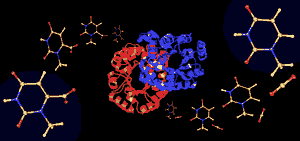Rational Functions
Introduction
|
| ||
The enzyme orotidine 5'-monophosphate decarboxylase and its substrates. | There are many ways to describe an enzyme's function- you can talk about the reaction(s) that it catalyzes, describe where and when the enzyme is active, or you can talk describe the reaction quantitatively. The study of enzyme kinetics is one such example. | |
When you first learn enzyme kinetics, you will quickly encounter the Michaelis-Menten equation, which relates the maximum velocity of an enzyme-catalzyed reaction to the concentration of substrate available as follows,
where V represents the reaction velocity, Vmax represents the maximum reaction velocity, Km represents the Michaelis-Menten constant, and [S] represents the substrate concentration. The velocity of the reaction, V,is dependent on the substrate concentration, [S]. The Michaelis-Menten equation is an example of a rational function. Would you feel comfortable using this equation in a problem set or laboratory exercise? The following tutorial should help you understand these functions an apply them to this and other biological problems. ***** In the next section we explore the basics of rational functions. | ||
The Biology Project > Biomath > Rational Functions > Introduction
Department of Biochemistry and Molecular Biophysics
The University of Arizona
April 2007
Contact the Development Team
http://www.biology.arizona.edu All contents copyright © 2007. All rights reserved.

